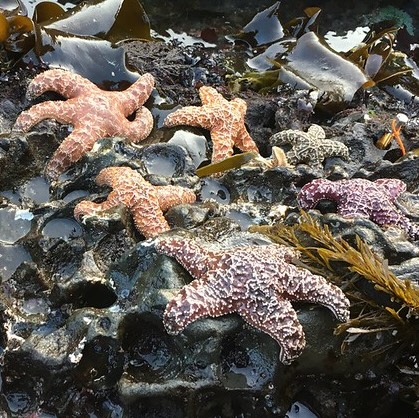Science
Ochre Sea Stars Show Signs of Recovery along Oregon Coast

Recent research indicates that ochre sea stars are beginning to recover along the Oregon Coast after suffering a significant population decline nearly a decade ago. This resurgence, described as a “baby boom,” is highlighted in a study conducted by scientists from Oregon State University and Cal Poly San Luis Obispo, published in the journal Ecosphere.
The study investigates populations across eight locations over a period of 23 years. It remains unclear whether this boom was a direct result of the wasting disease epidemic that previously brought ochre sea stars close to extinction in Oregon or if it was merely coincidental. Nevertheless, researchers observed numerous signs of recovery among the ochre sea star populations.
Lead author Sarah Gravem, who is now an assistant professor at Cal Poly, noted, “Wasting disease remains in circulation and populations continue to fluctuate, but there’s also much evidence that ochre sea stars are bouncing back.” The findings indicate that many of the young sea stars from the recent baby boom have reached adulthood, with current population numbers at or exceeding levels seen before the disease outbreak.
Bruce Menge, a distinguished professor of integrative biology at OSU, emphasized the significance of these findings. He stated, “After declines in sea star numbers of up to 84% in 2014, we quickly saw an 8,000% increase in young sea stars landing on shore.” This substantial increase suggests that populations are beginning to fulfill their essential role as keystone predators in the intertidal zone. At approximately three-quarters of the study sites, predation on their main prey, California mussels, has notably improved.
The recovery of sea stars has broader ecological implications. By preying on mussels, these sea stars help prevent mussels from forming dense beds that can hinder the growth of other marine species. Gravem further explained, “We showed that sea stars have now grown abundant and large enough that they are eating mussels at similar rates to before the epidemic at most sites in Oregon.”
Despite this positive trend, the study revealed that the average body sizes of the sea stars are still about 25% to 65% smaller than they were at most locations prior to the epidemic. Additionally, the populations across the coast are less stable from year to year compared to pre-epidemic conditions. The researchers attribute this variability to ongoing fluctuations in young sea star recruitment and intermittent resurgences of the wasting disease.
“The connection between the sudden decline of ochre sea stars and the baby boom remains elusive,” Gravem acknowledged. “It’s certainly possible they are linked, which would mean these sea stars may be resilient to mass mortality events. It is also possible that the baby boom was unrelated to the disease, and simple luck enabled this relatively rapid recovery.”
The cause of the wasting disease, which leads to symptoms such as lesions and twisted arms, has been traced to a strain of the bacterium Vibrio pectenicida. Research efforts led by scientists from the University of British Columbia, the University of Washington, the U.S. Geological Survey, and the Hakai Institute recently uncovered this crucial information, as detailed in a publication in Nature Ecology & Evolution.
As the ochre sea stars continue to recover, ongoing monitoring will be essential to understand the dynamics of their populations and the ecological balance along the Oregon Coast.
-

 Science2 weeks ago
Science2 weeks agoIROS 2025 to Showcase Cutting-Edge Robotics Innovations in China
-

 Politics2 weeks ago
Politics2 weeks agoJudge Considers Dismissal of Chelsea Housing Case Citing AI Flaws
-

 World2 weeks ago
World2 weeks agoBravo Company Veterans Honored with Bronze Medals After 56 Years
-

 Lifestyle2 weeks ago
Lifestyle2 weeks agoStone Island’s Logo Worn by Extremists Sparks Brand Dilemma
-

 Top Stories2 weeks ago
Top Stories2 weeks agoIndonesia Suspends 27,000 Bank Accounts in Online Gambling Crackdown
-

 Health2 weeks ago
Health2 weeks agoStartup Liberate Bio Secures $31 Million for Next-Gen Therapies
-

 Sports2 weeks ago
Sports2 weeks agoMel Kiper Jr. Reveals Top 25 Prospects for 2026 NFL Draft
-

 Health2 weeks ago
Health2 weeks agoTop Hyaluronic Acid Serums for Radiant Skin in 2025
-

 World2 weeks ago
World2 weeks agoHoneywell Predicts Record Demand for Business Jets Over Next Decade
-

 Politics2 weeks ago
Politics2 weeks agoNew Jersey Voters Urged to Register Ahead of November Election
-

 Lifestyle2 weeks ago
Lifestyle2 weeks agoMary Morgan Jackson Crowned Little Miss National Peanut Festival 2025
-

 Sports2 weeks ago
Sports2 weeks agoYamamoto’s Mastery Leads Dodgers to 5-1 Victory in NLCS Game 2








